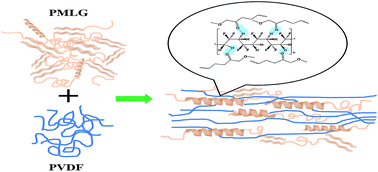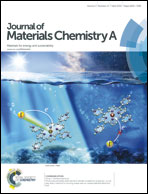Significant piezoelectric and energy harvesting enhancement of poly(vinylidene fluoride)/polypeptide fiber composites prepared through near-field electrospinning†
Abstract
In this study we applied near-field electrospinning (NFES) to prepare ordered poly(vinylidene fluoride) (PVDF)/poly(γ-methyl L-glutamate) (PMLG) composite fibers displaying enhanced piezoelectricity. Using Fourier transform infrared (FTIR) spectroscopy and differential scanning calorimetry (DSC), we analyzed the miscibility, specific interactions, and secondary structures of the PVDF/PMLG composites. The NFES process improved the piezoelectric properties of the PMLG/PVDF composites, resulting in better orientation of their dipoles, a high ultimate stress (27.47 MPa), and a high Young's modulus (2.77 GPa), as determined through micro-tensile testing. After patterning PVDF/PMLG piezoelectric composite fibers onto a poly(ethylene terephthalate)-based structure with parallel electrodes, we obtained a flexible PVDF/PMLG energy harvester that could capture ambient energy with a maximum peak voltage of 0.08 V, a power of 637.81 pW, and the energy conversion efficiency is 3.3%. The electro-mechanical energy conversion efficiency of this PVDF/PMLG energy harvester was up to three times higher than those of pristine individual PVDF and PMLG energy harvesters. Such PMLG/PVDF piezoelectric composite fibers exhibiting good piezoelectricity and good mechanical properties might have applicability in several fields, including biomedical engineering, green energy, wearable sensors, and energy harvesting.


 Please wait while we load your content...
Please wait while we load your content...